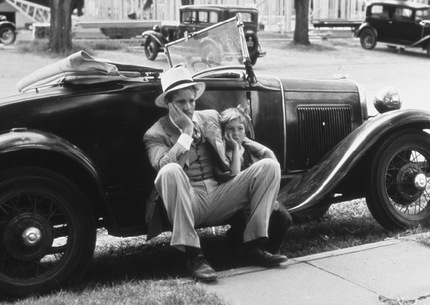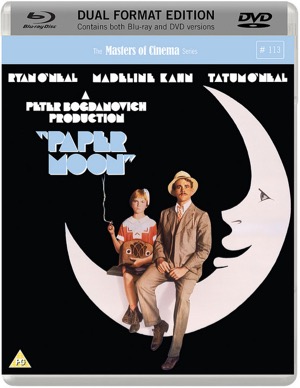Learning From The Masters Of Cinema: Peter Bogdanovich's PAPER MOON

Perhaps best known as the film for which a ten-year-old Tatum O'Neal won herself a Best Supporting Actress Academy Award, Peter Bogdanovich's Paper Moon is a beautifully constructed Depression-era caper brimming with heart and powered by a pair of flawless performances.
While attending the funeral of an old lady friend, con artist Moses Pray (Ryan O'Neal) meets the woman's nine-year-old daughter, Addie (Tatum O'Neal). Despite acknowledging a physical resemblance that suggests Moses may in fact be her biological father, he is reluctantly coerced into driving the young girl from Kansas to her aunt's house in neighbouring Missouri.
Moses, or Moze as she calls him, pays a visit to the brother of the man responsible for Addie's mother's death, and manages to squeeze $200 out of him, supposedly for the girl. Addie overhears this and when Moze proceeds to spend the majority of the cash on his car, Addie demands he pays her back. Begrudgingly, Moze agrees, but soon Addie displays a shrewd proficiency for - and willingness to become involved in - Moze's bible sales scams, and soon the unlikely duo are raking in the cash.
Shot in stark black and white by cinematographer Laszlo Kovacs (Easy Rider, Five Easy Pieces), and employing only popular music from the period, Bogdanovich does a wonderful job of recreating the American MidWest of the 1930s (transplanting the story from the source novel's original Deep South setting). On the advice of Orson Welles, Kovacs used a red filter on his camera while shooting, which darkened the blue skies and gave the deep whites a chalky look in the film's final monochrome presentation.
Welles, long-time friend and mentor to Bogdanovich, is credited with a number of the film's stylistic choices. In addition to the use of filters, Kovacs also used wide-angle lenses - a Welles signature - to achieve deep focus within almost every shot - a particular challenge as Bogdanovich chose to shoot the film in lengthy single takes. The director also changed the name of the film, from Addie Pray, after hearing the song It's Only a Paper Moon, which he used over the opening credits. On asking Welles' opinion, the formidable director apparently responded, "That title is so good, you shouldn't even make the picture, just release the title."

Paramount Pictures needed more convincing, however, as Joe David Brown's novel Addie Pray had been a bestseller. As a result, the scene in which Addie has her photo taken sitting on a cut-out crescent moon was added into the screenplay. The photo proves pivotal to the film's climax, and a version of it was even used for the film's poster. As a result, Bogdanovich got to keep his new title. The film proved to be one of only three pictures produced by The Directors Company - a collaboration with Francis Ford Coppola and William Friedkin - and released by Paramount. Coppola's Palme d'Or winner The Conversation and Bogdanovich's disastrous Daisy Miller being the others.
When casting the crucial role of Addie, it was Bogdanovich's ex-wife and production designer Polly Platt who suggested casting the untested Tatum O'Neal. The project was originally to be directed by John Huston, with Paul Newman and his own daughter Nell Potts in the central roles. When Huston passed, the cast also left the project. Bogdanovich had just finished working with Ryan O'Neal on What's Up, Doc?, during which time he had also met Tatum. Apparently, when the precocious youngster clocked the director as a guy unlikely "to take his shirt off on the beach", Bogdanovich instantly warmed to this wise-beyond-her-years youngster.
Beyond the central partnership, Bogdanovich brought back a number of actors he had previously collaborated with, either on What's Up, Doc? or his great success from 1971, The Last Picture Show. Madeline Kahn was also nominated for an Academy Award, in the same category as Tatum, for her role as feisty exotic dancer Trixie Delight. It is her seduction of Moze - and Addie's elaborate efforts to get rid of her - that make up the film's second act. John Hillerman (Higgins from Magnum, P.I.) takes on a dual role in the film's final third, as a local sheriff and his bootlegging brother, who are first swindled by, then get their violent revenge on, Moze. Noble Willingham and Randy Quaid also pop up in small roles along the way.
While reviews for Paper Moon were not uniformly positive when the film was released - with some critics struggling to reconcile the film's smart humour and classical aesthetic - the film proved a commercial hit. In fact, the film was so successful that it even spawned a TV series on ABC, starring Jodie Foster and Christopher Connelly, which proved less successful, and lasted only 13 episodes. In total, Paper Moon was nominated for four Academy Awards, including Best Adapted Screenplay and Best Sound, but O'Neal was the only victor on the night. Attending the ceremony without O'Neal Sr. or Bogdanovich, the clearly astonished O'Neal said simply "All I really want to thank is my director, Peter Bogdanovich, and my father. Thank you."
The beautiful 1080p transfer of the new Masters of Cinema blu-ray of the film gifts audiences the perfect opportunity to revel in this gorgeously constructed piece of American New Wave cinema. Kovacs' cinematography, Verna Fields' editing, Bogdanovich's frighteningly assured direction and a cast of likeable, authentic performances make Paper Moon an absolute joy from start to finish. Bogdanovich provides a typically absorbing, anecdote-riddled audio commentary (recorded in 2003), and the release also includes a trilogy of new featurettes on the production, including interviews with various crew members. A booklet is also included, featuring new writing on the film by Mike Sutton. All in all, this proves a flawless release of a genuine American classic.
Paper Moon is released on dual-format Blu-ray/DVD from The Masters of Cinema series today.

Do you feel this content is inappropriate or infringes upon your rights? Click here to report it, or see our DMCA policy.





